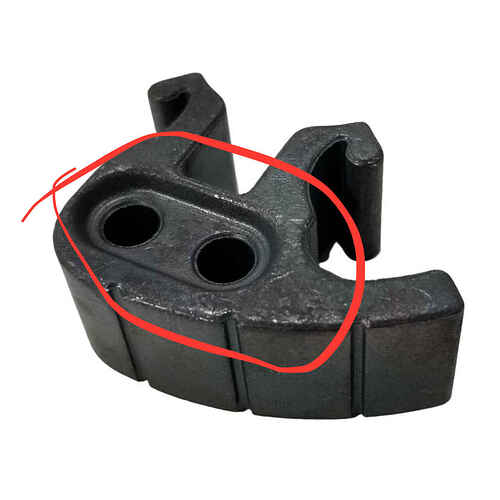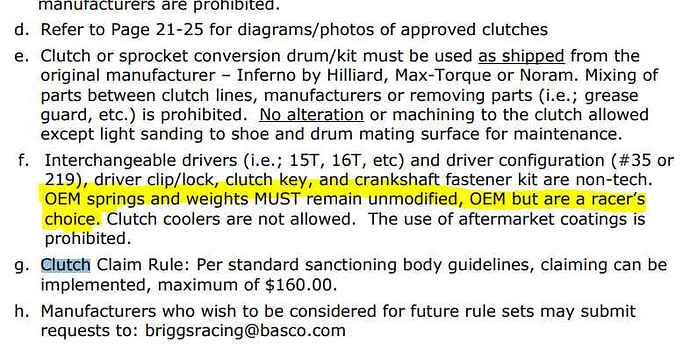Was talking to a guy at the track running a Hilliard Flame with clutch weights in Lo206. I have to admit I’d never heard of such a thing. Anyone else use them or have experience using them? Did a search here and on YouTube, didn’t find anything on the subject.
To the best of my knowledge; they affect the RPM activation of the clutch.
For example;
4 black springs, no weights, activate at about 3800rpm
4 black springs, 1 weight per shoe activates at about 3600rpm, and
4 black springs, 2 weights per shoe activates at about 3400rpm
So by using a, Engine RPM map in RaceStudio you can figure out where your lowest RPM on the track is and tune your engine for that (or something else specific for your track) you can fine tune the activation point.
I’ve used them and heard of other people using them as well, but there really isn’t time to be found. Clutch is always locked up on track anyway, but theoretically using weights should make the clutch more consistent.
Yes, I have 4 heavy and 4 light on my clutch, also 2 black + 2 yellow spring. The only reason I did it is for the standing start. I can have a much better launch with it.
If you have a really tight hairpin it might also helps, like really really tight hairpin with weird camber on it.
Check your mychron. If, during a lap on your track, the engine never gets below clutch engagement, then there is 0 time to be found.
So clutch engagement being at a specific rpm, let’s say 3600… what happens when you bog below? The kart engine needs to spool up and then the clutch bites suddenly? Or does it slip like my rental karts and slowly grab?
The clutch disengages and then re-engages slowly just like when you take off from the pits. On most sprint tracks around me, this never happens. Even the “tight tracks”, you are geared so low that you never get down there. Whiteland center hairpin and Camden “turn A” are two of the tightest corners ever but because you are running 3.75ish gear ratio, you never get down there.
Been a while since I have done national layout at New Castle, but I think you might get on the clutch if you are too slow through the left hander after the horseshoe.
Hmmm. Thanks. I wonder if ovrp is one of those tracks where the hairpin requires messing with engagement point.
Can you snap a pic of your clutch with the weights affixed? I’m struggling to visualize/ see how they attach? I don’t think I’ve ever seen them, but maybe I have and I just didn’t realize it.
I’m at work right now but two snap rings hold the cylindrical weight in the holes of the clutch shoes. One on each side of the shoe.
Really!? I thought they would affix to the holes in the drum. Interesting, thanks.
you can order a weight kit from TS racing
I was looking at the CKNA Rulebook, are these things allowed? I couldn’t find them mentioned anywhere.
Yes, absolutely. Very common and in about half the clutches in the field.
Not as clear as I wish it was, but here is the Briggs 206 rules (referenced by CKNA rules)
I run 2 black and 2 white. I don’t mess with the weights at all for the reasons already listed, but to add, I don’t really want all those extra parts in my clutch giving me something to worry about.
Hi all. New to the forum. Just noticed this topic. Just to clarify. When we are flying down the straight (Eg: 50mph at say 5900 rpm) and we take our foot off the accelerator. Does the rpm of the engine go to idle? Or does it still turn at 5900rpm because we haven’t braked to a lower speed yet?
Regards
BM
The clutch stays engaged and causes the engine to spin with the chain until the kart slows enough that the clutch is below its “disengagement speed”.
Short answer: it keeps turning at speed
Initially, I was in agreement but the more I think about this I’m not so sure. The clutch requires centrifugal force from the crankshaft to spin the shoes and with enough force overcome the springs so the shoes fling out and touch the drum. The clutch drum spinning in the scenario we are referencing wouldn’t affect the springs or shoes so they should disengage. This doesn’t happen immediately so the disengagement takes some time as the motor spins slower and while racing likely doesn’t happen very often. A way to test this would be to turn the ignition off while running at high speed. Would you coast (disengaged) or would the motor stop that from happening and act as a brake (engaged)?
Does the shoe care where the force is coming from? Whether the drum is forcing the shoe to spin or the hub is forcing the shoe, it doesn’t care. Enough speed and it will stay engaged.
By your rationale, the clutch would come disengaged multiple times per lap regardless of corner RPMs. That simply doesn’t happen in real life. Look at your Mychron traces.


